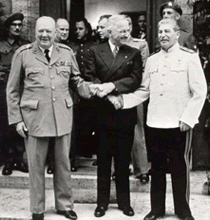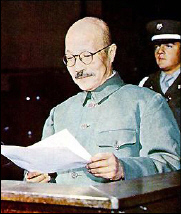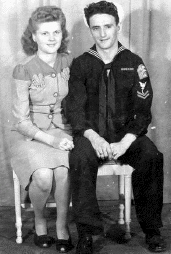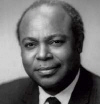Multiple Choice
Identify the
choice that best completes the statement or answers the question.
|
|
|
PREPARATION FOR
PEACE
In February 1945, Roosevelt had met with Churchill and Stalin at the
Soviet city of Yalta on the Black Sea. At the Yalta Conference, the three leaders made a number
of important decisions about the future. They agreed to move ahead in creating a new international
peacekeeping body, the United Nations (UN), based on the principles in the Atlantic Charter.
In exchange for Japan's Kuril and Sakhalin islands, Stalin promised to enter the war against
Japan after the surrender of Germany. He also promised "free and unfettered elections" in
Poland and in other Soviet-occupied Eastern European countries.
Yalta
What to do after the War is Over

Churchill, Truman
& Stalin at the Yalta Conference |
The following April, representatives of 50 nations met
in San Francisco to establish the United Nations. By June they had agreed on a charter. The charter
created the General Assembly,
which was made up of all member nations and was expected to function as a "town meeting of the
world." The charter also set up administrative, judicial, and economic governing bodies
An 11-member Security Council held the real power, though. The five main wartime
Allies-the United States, Great Britain, the Soviet Union, France, and China-were given permanent
seats on the Security Council. At the insistence of the Soviet Union and the United States, each
permanent member had the power to veto any council action . The other six seats rotated to countries
elected by the General Assembly. As the charter was signed, hopes were high that the Security Council
would be far more effective than the League of Nations at keeping world peace
| | |
In July 1945,
President Truman met with Churchill and Stalin at Potsdam in defeated Germany. In addition to drawing
up a blueprint for disarming
Germany and eliminating the Nazi regime, the Allies agreed that "stern justice shall be
meted out to all war criminals, including those who have visited cruelties on our prisoners .
,
|
|
|
1.
|
While the U.S. and England were
fighting Japan, the Soviet Union refused to help.Why did the Soviet Union finally agree to declare
war on Japan in 1945?.
a. | The Soviets were afraid the U.S.
would invade them | c. | The Soviets were
afraid that the U.S. would drop atomic bombs on them | b. | The U.S. and England agreed to let the Soviets occupy the
Kuril and Sakhalin islands in Japan | d. | The U.S. and England agreed to allow the Soviet Union to take over Eastern
Europe and China |
|
|
|
2.
|
What two things did the U.S.,
England and the Soviet Union decide at Yalta in 1945?
a. | the United Nations and rebuilding
Europe | c. | the United Nations and a plan for
the Soviets to declare War on Japan | b. | the takeover of China by the Communists | d. | all of these statements are true |
|
|
|
3.
|
The first United Nations met at
San Francisco. How did the charter organize the U.N.?
a. | House of Representatives and
Security Council | c. | House an
Senate | b. | Senate and General Assembly | d. | General Assembly and Security
Council |
|
|
|
4.
|
The U.S., Great Britain and the
Soviet Union met at Potsdam in July, 1945. What post war problem did they work
on?
a. | how to disarm and punish the
Nazi’s | c. | how to rebuild
Europe | b. | how to organize the United Nations | d. | how to get the Soviet Union to declare war on Japan and help the
allies |
|
|
|
THE NUREMBERG WAR
TRIALS
In accordance with decisions made at Potsdam, Germany was divided into four zones, or sectors . The
United States, Great Britain, France, and the Soviet Union each occupied and administered one zone.
Germany's capital, Berlin, although within the Soviet zone, was also divided into four sectors,
each administered by one of the occupying powers .
During the next year, in an unprecedented
move, an international tribunal representing 23 nations tried Nazi war criminals in Nuremberg,
Germany. Twenty-two Nazi leaders were tried at the first of the Nuremberg trials . They included
Hitler's most trusted party officials, government ministers, military leaders, and powerful
industrialists. As the trial began, U .S. Supreme Court justice Robert Jackson explained the
significance of the event.
Twelve of the 22 defendants were sentenced to death, and most of
the rest to prison. In later trials of lesser leaders, nearly 200 more Nazis were found guilty of war
crimes. For the first time in history a nation's leaders had been held legally responsible
for their actions during wartime
|
|
|
5.
|
What happened at Nuremberg
after World War Two?
a. | plans were made to re-arm
Germany | c. | the Japanese and
German leaders were put on trial for war crimes | b. | the former Nazi leaders were put on trial for war
crimes | d. | plans were made to disarm
Germany |
|
|
|
6.
|
At the Potsdam conference the
Allies decided to divide Germany into _____ sectors.
a. | five | c. | German, American, British and
Soviet | b. | Allied and Axis | d. | American, French, British and
Soviet |
|
|
|
7.
|
The German capital of Berlin
was located inside the _____ sector
a. | Axis | c. | American | b. | Allied | d. | Soviet |
|
|
|
THE OCCUPATION OF JAPAN
Japan was occupied by U.S.
forces under the command of General
Douglas MacArthur. In the early months of the occupation, more than 1,100 Japanese, from former
prime minister Hideki Tojo to lowly prison guards, were arrested and put on trial. Seven, including
Tojo, were sentenced to death. In the Philippines, in China, and in other Asian battlegrounds,
additional Japanese officials were tried for atrocities against civilians or prisoners of
war.

General MacArthur and Emporer
Hirohito | 
Tojo on trial for war
crimes | | |
During the
six-year American occupation, MacArthur reformed Japan's economy by introducing free-market practices
that led to a remarkable economic recovery. MacArthur also worked to transform Japan's
government. He called for a new constitution that would provide for woman suffrage and guarantee
basic freedoms . General MacArthur installed a democratic government presided over by a
very human emperor and based on the will of the people as expressed in free elections .To this
day, their constitution is known as the MacArthur Constitution.
Having taken care of
responsibilities to its allies and its enemies, America was ready to begin rebuilding at
home.
|
|
|
8.
|
Who was in charge of the
American occupation forces in Japan after WWII who helped Japan to make the transition to a
democratic nation
a. | General Dwight
Eisenhower | c. | Douglas
MacArthur | b. | prime minister Hideki Tojo | d. | Harry Truman |
|
|
|
9.
|
What was the MacArthur Constitution?
a. | MacArthur’s plan for punishing
former Japanese war criminals | c. | Japan’s constitution that MacArthur helped the Japanese to
write. | b. | A plan made by MacArthur to protect South Korea from the Communist
North | d. | MacArthur’s plan to rearm Japan for a possible war
with Communist China |
|
|
|
Opportunity and
Adjustment
World War II was a time of opportunity for millions of Americans. Jobs
abounded, and despite rationing and shortages, there was money to spend again. The war was
America's shining moment, and the nation emerged as the world's dominant economic and
military power.
ECONOMIC GAINS
The war years were good ones for working
people . As defense industries boomed, unemployment fell to a low of 1 .2 percent in 1944. Even
with price and wage controls, average weekly paychecks rose 70 percent during the war. And although
workers complained about long hours, overtime, and night shifts, they were also able to save money
for the future . Some workers invested up to half their paychecks in war bonds.
Farmers
also prospered during the war. Unlike the depression years, when farmers had battled dust storms
and floods, the early 1940s had good weather for growing crops. Farmers also benefited from
improvements in farm machinery and fertilizers and reaped the profits from rising crop prices . As a
result, crop production increased by 50 percent, and farm income tripled. Before the war ended, many
farmers could pay off their mortgages.
Women also enjoyed employment gains during the war,
although many lost their jobs when the war ended. Over 6 million women entered the work force for the
first time, boosting the percentage of women the total work force to 35 per cent. A third of those
jobs were in defense plants, which offered women more challenging work and better pay than such
traditional female jobs as waitressing, clerking, and domestic service. With men away at war, many
women also took advantage of openings in journalism and other professions.
Because of
shortages during the war, people did not have much to buy. There was a shortage of houses and no
automobiles or other consumer goods were produced during the war. People just saved their money. When
American industry finally started to produce consumer goods again, people had lots of money to buy
things. This pent-up demand helped the economy to grow dramatically in the years following
World War Two.
|
|
|
10.
|
Which group made economic gains
during World War Two?
a. | Farmers | c. | Workers | b. | Women | d. | All of these groups |
|
|
|
11.
|
Which statement is true and
work during World War Two?
a. | Women moved into the workforce in
defense factories and the professions | c. | Very few women became defense workers. Most remained at
home. | b. | Woman got jobs in the defense industry but failed to get jobs in other areas
of the economy | d. | Women got jobs in the professions
but did not make enough money to encourage them to work in defense
plants |
|
|
|
12.
|
What is it called when people
have a-lot of money and nothing to spend it on?
a. | supply-side
economics | c. | pent-up
supply | b. | savings cycle | d. | pent-up demand |
|
|
|
Population
Shifts
In addition to revamping the economy, the war
triggered one of the greatest mass migrations of American history. Not only were millions of
servicemen and women sent to places all over the world, but civilians were on the move as well.
Americans whose families had lived for decades in one place suddenly uprooted themselves to
seek war work elsewhere .
States with military bases and defense industries, such as Connecticut, Delaware, Maryland,
Michigan, Florida, and the Pacific Coast states, all experienced large population gains. More
than a million newcomers poured into California between 1941 and 1944. Towns with defense industries
saw their populations double and even triple, sometimes almost overnight.
Burbank, California, the home of a major aircraft company, grew from
12,000 to 60,000 people in the first two years of the war. The populations of some major
cities-including Washington, D.C., Los Angeles, San Francisco, Portland, Seattle, San Antonio, and
Dallas jumped by a third or more.
The inevitable result of such population booms was an
acute housing shortage. Even
though workers had money for rent, many were virtually homeless . They camped out in tents, old cars,
trailer parks, rented garages, and over crowded rooming houses . Food was a problem as well. Many
workers had no place to cook, yet because of food rationing, there were not enough restaurants
to feed them.
|
|
|
13.
|
What was the main reason for
the population shifts during World War Two?
a. | African Americans moved from the
South to escape persecution | c. | White people moved from the cities to escape urban violence and
gangs | b. | Workers moved to areas of the country that had defense
industries | d. | People moved from the cities to the
suburbs for better schools |
|
|
|
14.
|
Which statement is true about
population shifts during World War II?
a. | the civilian population that moved
experienced shortages | c. | there were housing
and transportation shortages but plenty of food | b. | there were food, housing and transportation shortages for
all Americans | d. | only the populations in non defense
areas experienced shortages |
|
|
|
SOCIAL
ADJUSTMENTS
Families adjusted to the changes brought on by war as
best they could. With millions of fathers in the armed forces, mothers struggled to rear their children alone .
Young children got used to being left with to work. Teenagers left at home without parents
sometimes drifted into juvenile delinquency. And when fathers finally did come home, there was
often a painful period of readjustment as families got to know one another
again.
 |
The war helped create new families,
too, as it triggered a huge marriage boom. Longtime sweethearts-as well as couples who barely knew
each other-rushed to marry
before the soldier or sailor was shipped overseas.
Many of these romances did not survive the
long separation, though. For numerous servicemen, the bad news came in much-dreaded "Dear
John" letters- letters from their wife or sweetheart, saying that she had found someone new.
In 1945, there were 502,000 divorces in the United States, or 31 for every 100 marriages .
This was double the prewar total and enough to give the United States the highest divorce rate in the
world.
| | |
In 1944, to help ease
the transition of returning servicemen to civilian life, Congress passed the Servicemen's
Readjustment Act, better known as the GI Bill of Rights. This bill provided education and training for veterans, paid
for by the federal government. Just over half the returning soldiers, or about 7.8 million veterans,
attended colleges and technical schools under the GI Bill. The act also provided federal loan
guarantees to veterans buying homes or farms or starting businesses. Because of this act,
millions who would otherwise never have been able to afford a college education or a house
went to school, became homeowners, and improved their economic prospects after the
war.
|
|
|
15.
|
Which statement is
true.
a. | Because of stronger family bonds
during the war, teens felt more secure | c. | World War II did not produce many cultural changes to American
families | b. | Because of changes in family life during the war, teens gained more
independence | d. | Because of World War II girls turned
away from marriage and sought careers |
|
|
|
16.
|
What was the purpose of the GI
Bill of Rights?
a. | Make sure that the civil rights of
the returning servicemen are not violated | c. | See that returning soldiers are not prosecuted for war
crimes | b. | Make sure that returning African American servicemen get civil
liberties | d. | Provide service to help servicemen
adjust to civilian life. |
|
|
|
17.
|
What were “Dear
John” letters?
a. | Letters sent to GI’s by their
wives and girlfriends telling them they found someone new | c. | Letters sent to President John Kennedy during the
war | b. | Letters sent by wives and girlfriends complaining about toilet facilities on
military bases | d. | Letters sent that accepted or
proposed marriage. |
|
|
|
AFRICAN AMERICANS IN THE
MILITARY
For African Americans, World War II was a turning
point of sorts. On the one hand, segregation remained the rule in the military. Not only were African
Americans assigned to all-black units, but many of them were assigned to rigidly segregated camps in
the South for their training .
On the other hand, under great pressure from civil
rights organizations, the military no longer restricted its all-black units to menial tasks.
Many black units distinguished
themselves in combat, including the famous 92nd Infantry Division, nicknamed the Buffaloes. In
just six months of fighting in Europe, the Buffaloes won 7 Legion of Merit awards, 65 Silver Stars,
and 162 Bronze Stars for courage under fire. The 99th Fighter Squadron, better known as the
Tuskegee Airmen, won two Distinguished Unit Citations (the military's highest
commendation) for its outstanding aerial combat against the German Luftwaffe.
AFRICAN
AMERICANS AT HOME
African Americans also made some progress on the home front. During the
war, about 330,000 blacks left the South . The majority moved to the West Coast. There they found not
only jobs, but good jobs . In 1942, civil rights leader James Farmer founded an interracial
organization called the Congress of Racial Equality (CORE) to confront urban segregation in
the North. That same year, CORE staged its first sit-in at a segregated Chicago restaurant

James Farmer
|
|
|
18.
|
Which statement is
true?
a. | African Americans in the military
were not assigned to combat duties until 1946 | c. | African Americans were assigned to ground combat but prohibited from flying
airplanes | b. | At first African Americans were assigned to non-combat duties until civil
rights organizations pressured for change | d. | There were no restrictions on African Americans in the
service |
|
|
|
19.
|
James Farmer started CORE to
integrate African Americans in Northern cities
|
|
|
JAPANESE AMERICANS IN THE
WAR EFFORT
For Japanese Americans locked up in U.S. internment camps, the war was a
daily struggle to maintain their dignity in the face of injustice. Many young men escaped the camps
by volunteering for military service.
At the urging of General Delos Emmons, the army created
the 100th Battalion, which consisted of 1,400 Hawaiian Nisei. The 100th fought in North Africa and
Italy, where it saw brutal combat, becoming known as the Purple Heart Battalion because 300
of its soldiers were killed and another 650 were Wounded
Later the 100th was merged into
the all-Nisei 442nd Regimental Combat Team, whose slogan was "Go for Broke." It became
the most decorated combat unit of the war. The 442nd took heavy casualties-more than one
fourth of the unit-in the Italian campaign and then was ordered to France, where the Nisei captured
the town of Bruyeres in house-to-house fighting. After that they were sent to rescue the "Lost
Battalion--a unit of 211 Americans surrounded by the Germans in the Vosges Mountains.
Japanese Americans also fought for justice, both in the courts and in Congress . The initial
results were discouraging . In 1944, the Supreme Court decided, in Korematsu v. United States,
that the government's policy of evacuating Japanese Americans to camps was justified on the
basis of "military necessity." After the war, however, the Japanese American Citizens
League (JACL) pushed the government to compensate those sent to the camps for their lost property. In
1965, Congress authorized the spending of $38 million for that purposeless than a tenth of Japanese
Americans' actual losses . In 1942 the Federal Reserve Bank in San Francisco estimated that the
relocation had cost evacuees $400,000,000
|
|
|
20.
|
What was the Purple Heart
Battalion?
a. | an army unit made up of 1,400 Hawaii
Islanders | c. | an army unit made
up of 1,400 Japanese from the Los Angeles area | b. | an army unit made up of 1,400 Hawaii
Japanese | d. | an army unit made up of anyone in
the service who received a purple heart. |
|
|
|
21.
|
Where did the Japanese American
soldiers do most of there service?
a. | In battles over Japanese held
islands | c. | In the war in
Europe with frontline combat units | b. | In U.S. non-combat units | d. | In the war in Europe in service units such as truck drivers, cooks and supply
clerks |
|
|
|
22.
|
Who rescued the Lost Battalion
that was surrounded by Germans.
a. | George Patton’s third
army | c. | the all-Nisei 442nd Combat
Team, | b. | The Korematsu all Japanese combat unit | d. | a mixed Japanese, and German American 442nd Combat
Team |
|
|
|
23.
|
How did the Supreme Court rule
in the Korematsu v. United States case?
a. | Japanese Americans should receive
compensation for their illegal imprisonment during World War II | c. | the Japanese American Citizens
League (JACL) had no right to push the government to compensate Japanese
Americans | b. | The government had no right to put Japanese Americans in camps for the
duration of the war | d. | The government had a right to put
Japanese Americans in camps for the duration of the war |
|